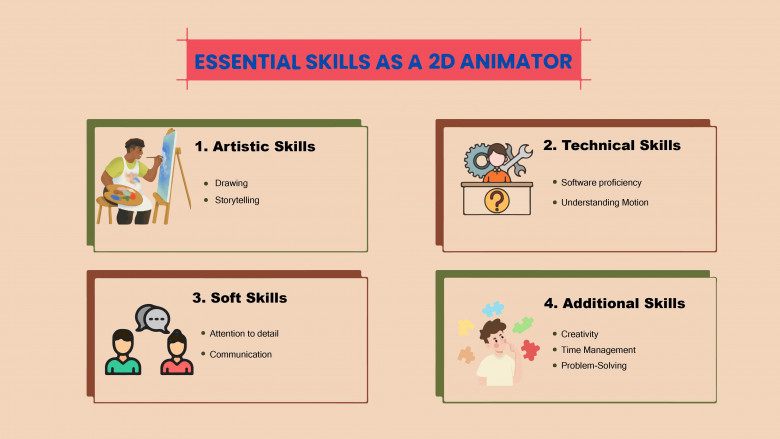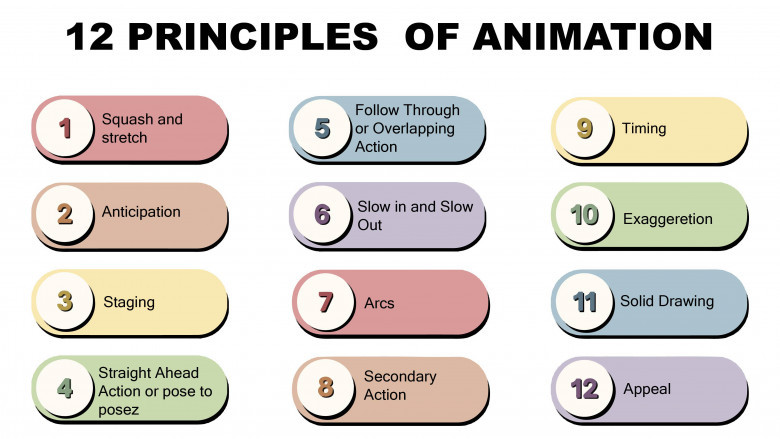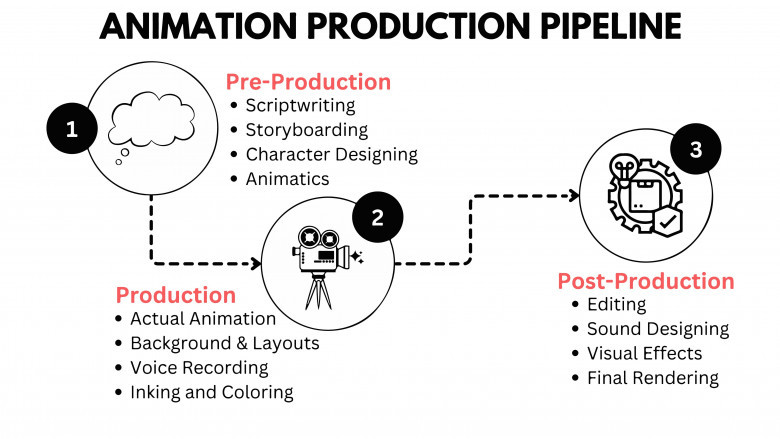views
What is 2D Animation?
2D animation is the art of creating movement in a two-dimensional space—a world where creativity seamlessly blends with technology. For more than a decade, I’ve been deeply immersed in this fascinating realm, and the magic of 2D animation continues to excite and inspire me every day.
At its core, a 2D animated film is built from characters, backgrounds, and effects, all crafted on a flat plane. Unlike 3D animation, which adds depth and volume, 2D animation focuses on height and width. Despite its simplicity, it carries a unique charm that has captivated audiences across generations. There's something timeless about the way it brings stories to life, one frame at a time.
Essential Skills as a 2D animator
Artistic Skills
Drawing : Drawing is the foundation of 2D animation, making a solid understanding of anatomy, perspective, and shading absolutely essential. In this art form, animators breathe life into characters with just a few carefully placed strokes—every line holds meaning and intention. The ability to convey motion, emotion, and personality through simple drawings is what sets skilled animators apart.
Storytelling: Animation, at its core, is not an issue of motion; rather, it is an act of storytelling. If done well, animation conveys emotion and tells a story in a very detail-oriented way, able to render static images dynamic and engaging.

Technical Skills
Technical Skills
Software Proficiency:
Modern 2D animation heavily relies on digital tools. Proficiency in industry-standard software like Adobe Animate, Toon Boom Harmony, and Clip Studio Paint is crucial. These programs not only streamline the animation process but also enable animators to add intricate details and maintain a smooth workflow.
Understanding Motion:
A deep grasp of how living beings move is essential. Animators must apply key principles such as Squash and Stretch, Anticipation, and Follow-Through to create believable, expressive motion that resonates with viewers.
Understanding these essential skills will help you make informed decisions—whether you're becoming an animator or hiring one. By recognizing what truly matters, you can ensure that your animation project is handled with skill, creativity, and professionalism, resulting in a high-quality final product that captivates your audience.
Understanding these essential skills will help you make informed decisions—whether you're becoming an animator or hiring one. By recognizing what truly matters, you can ensure that your animation project is handled with skill, creativity, and professionalism, resulting in a high-quality final product that captivates your audience.
Educational Pathways
Education and Learning Paths
Formal Education:
Many aspiring animators begin their journey with a degree in animation, graphic design, or related fields. These programs provide a strong foundation in both the artistic and technical aspects of animation.
Workshops:
Workshops offer hands-on experience and the chance to sharpen specific skills. They’re also excellent for networking and learning from industry professionals in a focused setting.
Online Courses and Tutorials:
There’s a wealth of free and paid online resources available—from structured platforms like Coursera and Skillshare to in-depth YouTube tutorials. These allow you to learn at your own pace, covering everything from basic principles to advanced animation techniques.
Self-Study and Practice:
Consistent practice is one of the most powerful tools for growth. Creating personal projects helps reinforce your skills, build your portfolio, and develop your unique animation style. The more you animate, the better—and more confident—you’ll become.
Learning the Basics of Animation

The 12 Principles of Animation
1. Squash and Stretch – Adds weight and flexibility to objects, like a ball squashing on impact and stretching in motion.
2. Anticipation – Prepares the audience for an action, such as crouching before a jump.
3. Staging – Directs focus to what's important in a scene through clear composition and timing.
4. Straight Ahead vs. Pose to Pose – Two animation methods: fluid and spontaneous (straight ahead) vs. planned keyframes (pose to pose).
5. Follow Through and Overlapping Action – Body parts continue moving after the main action, adding realism (like flapping ears after a stop).
6. Slow In and Slow Out – Adds natural movement by easing into and out of actions with extra frames.
7. Arcs – Natural motion follows curved paths; arcs make movement look fluid and organic.
8. Secondary Action – Supporting actions like facial expressions or swaying hair that enhance the main motion.
9. Timing – Controls the speed of actions to reflect weight, mood, and realism.
10. Exaggeration – Enhances movement or emotion to make scenes more dynamic and expressive.
11. Solid Drawing – Understanding form, weight, and anatomy gives 2D characters a 3D feel.
12. Appeal – Characters must be interesting and engaging, whether hero or villain.
Understanding the Animation Production Pipeline
Imagine the animation production pipeline to be a kind of roadmap that ushers a project from an idea to some cool animated piece. This pipeline consists of:

- ript laid out like a comic strip. It helps map out the sequence of events and visual flow.
- Character Design – Characters are visually developed to suit the tone, story, and personality traits needed in the film.
- Animatics – Storyboards are combined with voiceovers and temporary audio to create a rough version of the film. This helps in early pacing and scene planning.
Production: Bringing Ideas to Life
This is the heart of the animation process—where ideas become motion and art.
- Animation – Characters and objects are animated using frame-by-frame or keyframe techniques via software tools.
- Backgrounds and Layouts – The environments are designed, setting the stage for the character’s actions and interactions.
- Voice Recording – Voice actors record dialogues to match the animated characters, providing tone and personality.
- Inking and Coloring – Final visual touches are added, including linework and colour, to bring the animation to life.
Post-Production: Polishing the Final Product
This stage adds the finishing touches and assembles everything into a complete, polished film.
- Editing – All animated scenes are stitched together, ensuring continuity, pacing, and coherence.
- Sound Design – Music, sound effects, and audio enhancements enrich the atmosphere and emotional tone.
- Visual Effects (VFX) – Lighting, shadows, and other visual enhancements are added to give depth and realism.
- Final Render – The completed animation is exported in its final format and is ready for distribution or screening.






















Comments
0 comment